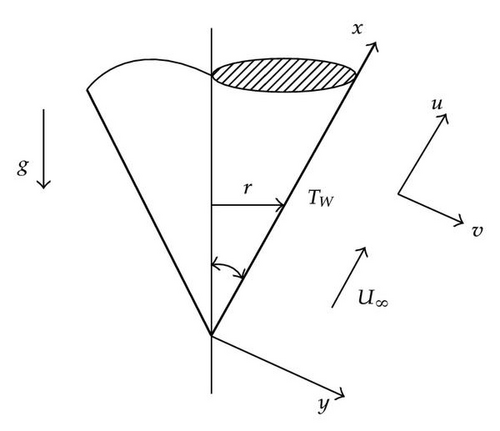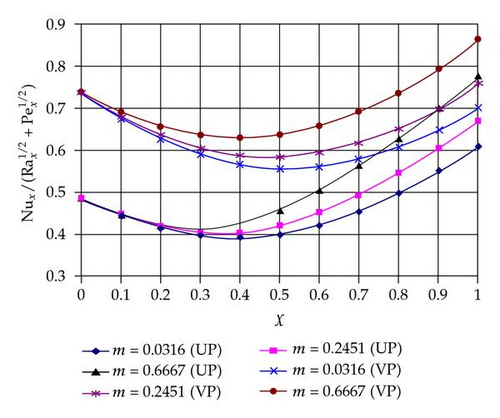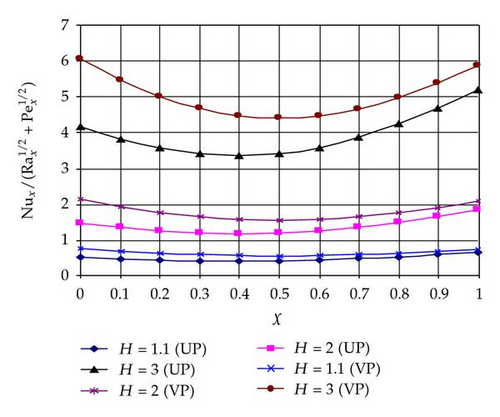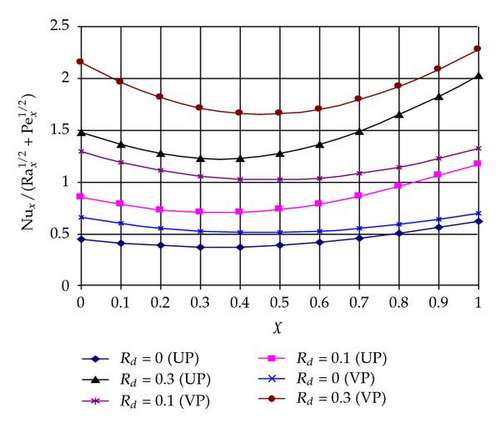Radiative Mixed Convection over an Isothermal Cone Embedded in a Porous Medium with Variable Permeability
Abstract
The interaction of mixed convection with thermal radiation of an optical dense viscous fluid adjacent to an isothermal cone imbedded in a porous medium with Rosseland diffusion approximation incorporating the variation of permeability and thermal conductivity is numerically investigated. The transformed conservation laws are solved numerically for the case of variable surface temperature conditions. Numerical results are given for the dimensionless temperature profiles and the local Nusselt number for various values of the mixed convection parameter χ, the cone angle parameter m, the radiation-conduction parameter Rd, and the surface temperature parameter H.
1. Introduction
The problem of convective heat transfer in porous medium has attracted researchers because of the several applications it incorporates. Examples include enhanced oil recovery, nuclear waste disposal, geothermal reservoirs, and ceramic processing. This topic has been extensively covered in literatures in connection with different geometries, boundary conditions, and media. While most of the cases concern with convection along semi-infinite vertical walls impeded in porous media (e.g., [1–5] and many others) several other geometries were also considered including cylinders (e.g., [6, 7]), wedges (e.g., [8]), spheres (e.g., [9], Huang et al., 1986), cones (e.g., [10]). The presence of thermal radiation was also investigated for the case of truncated cone by Yih [11] and for the case of vertical wall by Abbas et al. [12]. All these studies consider the permeability and conductivity of the medium as constant. However, porosity measurements by Schwartz and smith [13], Tierney et al. [14], and Benenati and Brosilow [15] showed that the porosity in the vicinity of solid objects is not usually constant. In other words, it varies from the wall to the interior of the porous medium which results in variations in the permeability as well as the equivalent thermal conductivity across the medium. Chandrasekhara et al. [16–18], and have incorporated variable permeability when studying convection in porous media and reported its significant impact on the velocity field and heat transfer.
The present paper considers the case of mixed convection and radiation about a cone immersed in a porous medium. It is assumed that the immersion of the cone has caused disturbances to the host porous medium domain resulting in the porosity, the permeability, and the effective thermal conductivity of the neighboring region to vary. This scenario may result during the underground disposal of the high-level nuclear waste contained in canisters of conical shape. That is, the reprocessing of depleted nuclear reactor fuel elements usually results in the formation of considerable quantities of high-level, long-lived radioactive waste. These wastes are usually adopted and cast in metallic cylinders and are stored in canisters which may lately be burred underground. The decay heat generated from the spent nuclear fuel may last for decades and therefore might result in the temperature to be high enough so as to make it important to include radiation heat transfer into consideration.
2. Analysis

3. Results and Discussion
Numerical results for the governing (2.8)-(2.9) and the boundary conditions (2.10) are nonlinear partial differential equations depending on the mixed convection parameter χ, the radiation-condition parameter Rd, and the surface temperature parameter H for both UP and VP cases. Numerical results are presented for the mixed convection parameter χ ranging from 0 to 1.0, the cone angle parameter m ranging from 0.03163 to 0.66672, the radiation parameter Rd ranging from 0 to 1, and the surface temperature parameter H from 1.1 to 3.0 for both uniform permeability (UP), that is, d = d* = 0 and variable permeability (VP), that is, d, d* ≠ 0 cases. For the purpose of numerical integration we have assumed that d = 3, d* = 1.5 and ε0 = 0.4 (Christopher and Middleman [22]).
Figures 2–4 display results for the Nusselt number for various values of m, Rd, χ and H for two cases UP and VP cases. From Figure 2, it is noteworthy that for pure free convection (χ = 0), there is no effect of the parameter m on the heat transfer rate on the surface, while for the pure forced convection (χ = 1), the parameter m enhances the heat transfer rate at the surface. It is observed from Figure 3 that the parameter H enhances the heat transfer rate, and Figure 4 shows that the parameter Rd enhances the heat transfer rate too. From Figures 2–4, it is interesting to note that the heat transfer rate at χ tends to 0 or 1 (i.e., at pure free and pure forced convection) and has the highest values.



Nomenclature
-
- ar:
-
- Rosseland mean extinction coefficient
-
- B:
-
- Constant
-
- Cp:
-
- Specific heat at constant pressure
-
- d:
-
- Constant defined in(2.5)
-
- d*:
-
- Constant defined in(2.5)
-
- f:
-
- Nondimensionless stream function
-
- g:
-
- Acceleration due to gravity
-
- h:
-
- Heat transfer coefficient
-
- K(y):
-
- Permeability of the porous medium
-
- kr:
-
- Thermal conductivity
-
- K0:
-
- Permeability at the edge of the boundary layer
-
- m:
-
- Cone angle parameter
-
- Nux:
-
- Local Nusselt number
-
- Pex:
-
- Local Peclet number
-
- qr:
-
- The rate of heat transfer
-
- qw:
-
- Surface heat flux
-
- r:
-
- Local radius of the cone
-
- Rax:
-
- Local Rayleigh number
-
- Rd:
-
- Radiation parameter
-
- T:
-
- Fluid temperature
-
- Tw:
-
- Wall temperature
-
- T∞:
-
- Free stream temperature
-
- u, v:
-
- Darcian velocity in the x and y directions
-
- u∞:
-
- Free stream velocity
-
- x, y:
-
- Coordinate axes along and perpendicular to the plate
-
- α(y):
-
- Thermal diffusivity
-
- α*:
-
- Ratio of viscosities
-
- α0:
-
- Thermal diffusivity at the edge of the boundary layer
-
- β:
-
- Volumetric coefficient of thermal expansion
-
- γ:
-
- Half angle of the cone
-
- ε(y):
-
- Porosity of the saturated porous medium
-
- ε0:
-
- Porosity at the edge of the boundary layer
-
- η:
-
- Dimensionless distance
-
- θ:
-
- Dimensionless temperature
-
- λ:
-
- Constant in(2.2)
-
- λm:
-
- Effective thermal conductivity of the porous medium
-
- μ:
-
- Viscosity of porous medium
-
- ν:
-
- Kinematics viscosity of the fluid
-
- ψ:
-
- Stream function
-
- ρ:
-
- Density of fluid
-
- χ:
-
- Mixed convection parameter
-
- σ*:
-
- Ratio of thermal conductivity of the solid to the liquid
-
- σ:
-
- Permeability parameter
Subscripts
-
- w:
-
- Surface conditions
-
- ∞:
-
- Condition far away from surface.




